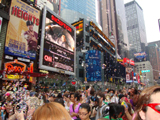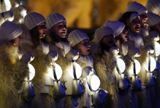Consciousness and health
The law of change — II
Abstract
This article deals with the individual’s role in our present times of great upheaval associated with the pressure for a collective change. It discusses the purpose of this change and the need to trust the future in the light of Sri Aurobindo. According to the author, the way lies neither in blind conservatism nor in fashionable modernity. We need to look beyond both and trust the Time-Spirit and act with a wide and plastic consciousness that looks at events and people and circumstances in their totality.
Unseen handsChange denotes two things, — a leaving behind of the present along with its burden of the past and a stepping ahead into the future along with the stress of the present. The present is a unique moment that contains within itself, concealed behind its fact, the past as well as the future. On the one hand the energies of the past act like a dying momentum, on the other hand it also contains a slowly developing seed that is pushing us into the future. Both these propulsions are often hidden from our sight. We only feel the impulsion of the moment and not the forces that push us. Yet, through all this error and blindness, through all this unconsciousness of the play of forces that binds and blinds us and the faulty imperfect instruments of our cognition and action, something keeps pushing us forward towards a future perfection we can only dream of and imagine now. While our acts and deeds prolong phantoms of the past through force of habit, our thoughts and feelings, our will and aspirations, our hopes and desires lay the foundations for a future that is being woven for us by the material that our inner being provides. That is why it is so important to watch over our thoughts and motives that are often hidden behind the veil of our outer actions. And behind all these there is a secret Wisdom that uses our thoughts and feelings, as much as our deeds and their consequences, to push us towards unseen heights and unfelt glories of the Spirit within.
Jump-time
But while all this is going on behind the scene in an individual and within the framework of a person’s life, sometimes the momentum of change enters into a fast-forward mode. We suddenly jump time as it were. There is a clear sense of an intervention that changes completely not just the pace and mode but the very track of our life. During such moments we take a leap into the future instead of slowly advancing through all kinds of apparently ‘good’ and apparently ‘bad’ or, as we are used to terming it, pleasant and painful experiences of life. We are suddenly brought face to face with something very deep and true, more real than anything else. In the light of this experience the sense and purpose of life changes, giving a new meaning to our past, present and future. This leap or an accelerated mode of evolution can be very disorienting to our set patterns of thought and feelings. We break out of the limited and fixed frame and step into another dimension with endless possibilities. Sometimes this kind of a change is felt as a great upheaval. Our entire life, within and without, and all that is connected with us, undergoes a massive change. All the fixed relations of our self with the world around us also suffer the shock of the change. Sometimes this may even be felt as a crisis, a confusion, even a chaos where we come face to face with a battle where we have to make a crucial choice of destiny, — whether to continue with the habitual patterns of the past or else to be bold and courageous and embrace the future with trust.
This is not easy. And yet we cannot stay for long with the past momentum once this fire of change has touched us. If we refuse the impulsion that has arisen from some depths of our nature or descended from some unseen heights like lightning from the sky then we are unable to feel the same level of integration with the past that we felt before the shock of the future stunned and surprised us. We must step forward with trust in the Wisdom that has gone forth into the world or else fall backward. For, in such moments there is nothing like remaining static. If we lose the moment of destiny, then the giant wave of Time that arose from the unseen depths to carry us afar simply moves ahead and we then feel the void of the sinking wave and the rumour of distant seas that called us but to which we paid no heed. Having glimpsed that moment, we can never quite be the same or feel happy and integrated with the world and self as before. These moments come not only in the individual’s life but also in the life of collectivities, of nations and empires, of various groups of mankind. These are moments when the cry for change is heard exceptionally loud and the stress of change becomes exceptionally strong. This is the significance of these special evolutionary moments called the ‘Hours of God’.
The Hour of God
In one of Her messages for the opening of the sports season on 1st April 1971, the Mother (1) revealed:
“We are at one of these ‘Hours of God’, when the old bases get shaken, and there is a great confusion; but it is a wonderful opportunity for those who want to leap forward, the possibility of progress is exceptional.
“Will you not be of those who take advantage of it?
“Let your body be prepared through physical education for this great change!”(p. 279).
We are indeed living in such a moment when a future from afar is precipitating itself amidst the human race. These are interesting times of transition when one loop of Time changes track after completing its evolutionary curve. In the process many things shift their places, others change even when they remain where they were. Still others are simply left aside broken by the advancing feet of Time that has been conjured so powerfully in the Indian experience as the vision of Kali whose dance destroys the hard crust of life that has accumulated over the millennia and releases the secret Godhead Shiva, the eternal Mahakala, who sleeps within it. Then only, the mighty dance stops and the all-devouring Force prepares the way for the all-creating rhythm of the divine dancer Krishna.
Today we see this happening characteristically. On one side a great destruction while, on the other side a great onrush of creative Energy, a speed and rush to conceive and create new things, things that amaze us with wonder but also at times fill us with fear. What is going to happen, what is going to happen, becomes the common refrain of the average humanity struggling to understand and adapt to the rapid pace of change taking place all around him. In fact so rapid is the change that sometimes there is little time left even to evaluate whether the change is good or bad. And even if one were to do so, the change is taking place under an unseen momentum, beyond logic, as if driven by an inbuilt mechanism independent of all our human efforts like an unstoppable force that we can watch helplessly but cannot resist.
Trusting the future
But we need not be merely helpless witnesses of this scene. We can not only understand but participate, not only participate but be the catalysts, not only be catalysts but actually become dynamic instruments to usher in the change. For whether it looks good or bad to the ignorant human eye, the Wisdom that works in Nature’s heart and the Time-Spirit always work towards the Good alone.
It is first of all with this assurance, this trust in the future that we must move. This trust is part of our trust in the Divine Wisdom that has gone forth into creation, — prajñā prasṛtā purāṇī.... In the language of yoga, it is called Kalyana Sraddha. In any case, doubt, distrust, fretting and fuming, complaining and grumbling do not help. On the contrary, they cloud our view and make things look darker than they actually are. This tendency to decry everything that is different and is changing around us soon gives way to pessimism and cynicism. Increasingly, we sulk in our little cocoons and comfort-zones unwilling to step out and be the change. Even if every change is not necessarily for the good from our limited human perspective, yet since change is inevitable it is much better that we participate in it and thereby try to give it some direction according to our conception of what may be best. Yet we should not forget that our so- called ‘best’ is at best only a relative best. At worst, it is simply an ignorant bias and preference for one way of life over another, nothing else.
The protagonists of the past always look back and think that their time was the best and that the past was always good. They are fearful of the future, sceptical of the usefulness of any change. On the other hand, the champions of the future often mistake a new fashion for authentic change. So let us first be clear about these two categories of changes. Fashion is merely a cosmetic change, an illusion that creates new and beautiful looking appearances. But it is merely an appearance. It does not endure and the old malady resurfaces under a new name. It is not this kind of a New World that Sri Aurobindo and the Mother foresaw and laboured to bring down upon earth. Nevertheless we need not be pessimistic when we see this kind of cosmetic change around us. For even this, as we have seen, serves a purpose or two.
First of all, it breaks the fixed formations of the past and thereby prepares the way for the future when the fashion passes away. Fashion thereby becomes not part of the new creation but a paradoxical means that Nature adopts to destroy the old under the garb of a new creation. This it does because while many may want the change, it is only the few who are willing to labour and suffer and endure and wait with the still patience of the unborn for the authentic change to come about. We are only too happy with symptomatic relief; few are willing to undertake lifestyle modification, attitudinal changes and all else that is needed for a radical remedy.
Secondly, palliatives and temporary solutions may buy time until the authentic change can come about, which is a long and painstaking process whose last steps only may appear as something marvellous and miraculous but the rest of the process takes time and effort like the birth of a child or the transmutation of a caterpillar into a butterfly. Change is not an instant cup of coffee and those who mistake change for a fast-food restaurant often despair when the first rush is over since they find themselves in the same soup as before, sooner or later.
Thirdly, sometimes what we call fashion is a first fumbling step towards the future. It is like an intermediate species that is a clumsy attempt to escape the limitations of the previous one but ends up being a strange mid-way product that is neither here nor there, like a half-delivered baby.
We can take two common examples from Nature, — adolescence and sleep. During adolescence, the formations of childhood are broken. There is a temporary disequilibrium which presents itself sometimes as an aimless wandering, an easy attraction to outward things, loss of inherited values and such phenomena that may well alarm an adult world. The innocent child who would listen to the parental authority and treat it with respect has collapsed. But wait a few years and after the turmoil of transition is over there is a re-orientation, a discovery of one’s own set of values, a search for deeper things and so on. Through this sudden change during adolescence, Nature achieves its purpose of bringing out new possibilities; otherwise children may well remain carbon copies of adults and thereby the task of evolution suffers a setback. A similar phenomenon takes place during sleep when the day’s anxieties and joys are forgotten in a state of oblivion which, if compared to our waking state, is almost like a helpless condition into which our being enters, like the inertia of the stone that has no thought, no feelings, no conscious motives, simply a mechanical continuation of the machinery of life. But this temporary setback or retrogression, if we may say so, is to prepare us for a new adventure each day. A similar phenomenon takes place following the death of our body and, at a larger cosmic scale, following the dissolution of an Age, what is called in Indian thought as a Pralaya. It is not an irretrievable and complete loss but a loss of all that has served its purpose, whose utility in our evolutionary march is over. The rest would re-emerge from Nature’s or the world’s long sleep and start afresh with renewed vigour and hope. Even learning from the experience of the past, consciously or unconsciously, it will start with a better note and a greater possibility. Yes, the moment of transition may be painful and long, especially when it concerns the transition from one Age to another, yet at the end of it we have a new birth and then we find that the long labour and pain of delivery were well justified.
Moments of transition
What we must avoid is a spirit of excessive conservatism as well as the rush towards a blind modernity. Conservatism prevents evolution by holding on to the past tenaciously. No doubt the past has its own glories but what we have to preserve is the spirit and not the forms and institutions that emerged out of it. Those forms may have been good and valid for a certain epoch but once that period of Time is over and a new page turned in the book of life, we must learn to advance forward. The looking back should only be to connect the thread with the future story that is unfolding and not with nostalgia to repeat the past. Nature does not write the same chapter again. It loves to create variations even when the theme is the same and the plot similar. So also a blind modernity does not help since we are driven and misled by any passing appearance and take it to be the authentic demand of the Age that is unfolding before us. A lot of time may be lost and at the end we discover only yet another disillusionment. A calm and steady outlook, a trust in the Divine Wisdom and the courage to heed Its leading are needed to embrace the Future.
Sri Aurobindo reveals to us the secret link that connects the past, present and the future. That secret link is not to be found in the outer forms and expressions in which the Spirit of an Age chooses to clothe itself but in the Spirit itself that gave it birth:
“The past is both a drag and a force for progress. It is all that has created the present and a great part of the force that is creating the future. For the past is not dead; its forms are gone and had to go, otherwise the present would not have come into being: but its soul, its power, its essence lives veiled in the present and ever-accumulating, growing, deepening will live on in the future. Every human being holds in and behind him all the past of his own race, of humanity and of himself; these three things determine his starting-point and pursue him through his life’s progress. It is in the force of this past, in the strength which its huge conservations give to him that he confronts the unillumined abysses of the future and plunges forward into the depths of its unrealised infinities. But also it is a drag, partly because man afraid of the unknown clings to the old forms of which he is sure, the old foundations which feel so safe under his feet, the old props round which so many of his attachments and associations cast their tenacious tendrils, but also partly because the forces of the past keep their careful hold on him so as to restrain him in his uncertain course and prevent the progress from becoming a precipitation.
“The future repels us even while it irresistibly attracts. The repulsion lies partly in our own natural recoil from the unknown, because every step into this unknown is a wager between life and death; every decision we make may mean either the destruction or the greater fulfilment of what we now are, of the name and form to which we are attached. But also it lies in the future itself; for there, governing that future, there are not only powers which call us to fulfil them and attract us with an irresistible force but other powers which have to be conquered and do not desire to yield themselves.
“The future is a sphinx with two minds, an energy which offers itself and denies, gives itself and resists, seeks to enthrone us and seeks to slay. But the conquest has to be attempted, the wager has to be accepted. We have to face the future’s offer of death as well as its offer of life, and it need not alarm us, for it is by constant death to our old names and forms that we shall live most vitally in greater and newer forms and names. Go on we must; for if we do not, Time itself will force us forward in spite of our fancied immobility. And this is the most pitiable and dangerous movement of all. For what can be more pitiable than to be borne helplessly forward clinging to the old that disintegrates in spite of our efforts and shrieking frantically to the dead ghosts and dissolving fragments of the past to save us alive?....
“The greatest spirits are therefore those who have no fear of the future, who accept its challenge and its wager; they have that sublime trust in the God or Power that guides the world, that high audacity of the human soul to wrestle with the infinite and realise the impossible, that wise and warrior confidence in its ultimate destiny which mark the Avatars and prophets and great innovators and renovators.....
“The partisans of the future call themselves the party of progress, the children of light and denounce the past as ignorant, evil, a mass of errors and abuses; their view alone has the monopoly of the light, the truth, the good — a light, good and truth which will equally be denounced as error and evil by succeeding generations. The partisans of the present look with horror upon all progress as an impious and abominable plunge into error and evil and degeneration and ruin; for them the present is the culmination of humanity, — as previous ‘present’ times were for all the preceding generations and as the future which they abhor will be for these unprogressive souls if they should then reincarnate; they will then defend it with the same passion and asperity against another future as they now attack it in the interests of the present....
“The true thinker can dispense with the éclat which attaches to the leader of partisans. He will strive to see this great divine movement as a whole, to know in its large lines the divine intention and goal in it without seeking to fix arbitrarily its details; he will strive to understand the greatness and profound meaning of the past without attaching himself to its forms, for he knows that forms must change and only the formless endures and that the past can never be repeated, but only its essence preserved, its power, its soul of good and its massed impulse towards a greater self-fulfilment; he will accept the actual realisations of the present as a stage and nothing more, keenly appreciating its defects, self-satisfied errors, presumptuous pretensions because these are the chief enemies of progress, but not ignoring the truth and good that it has gained; and he will sound the future to understand what the Divine in it is seeking to realise, not only at the present moment, not only in the next generation, but beyond, and for that he will speak, strive, if need be battle, since battle is the method still used by Nature in humanity, even while all the while he knows that there is more yet beyond beside which, when it comes to light, the truth he has seized will seem erroneous and limited. Therefore he will act without presumption and egoism, knowing that his own errors and those which he combats are alike necessary forces in that labour and movement of human life towards the growing Truth and Good by which there increases shadowily the figure of a far-off divine Ideal”(2).
References
1. The Mother. Collected Works of the Mother. 2nd ed. Volume 12. Pondicherry: Sri Aurobindo Ashram Trust; 2002.
2. Sri Aurobindo. Complete Works of Sri Aurobindo. Volume 13. Pondicherry: Sri Aurobindo AshramTrust; 1998, pp.128-32.
(To be continued)
Dr. Alok Pandey is a doctor practising at the Sri Aurobindo Ashram. He is also a member of SAIIIHR and an Editor of NAMAH.
Share with us (Comments,contributions,opinions)
When reproducing this feature, please credit NAMAH,and give the byline. Please send us cuttings.







